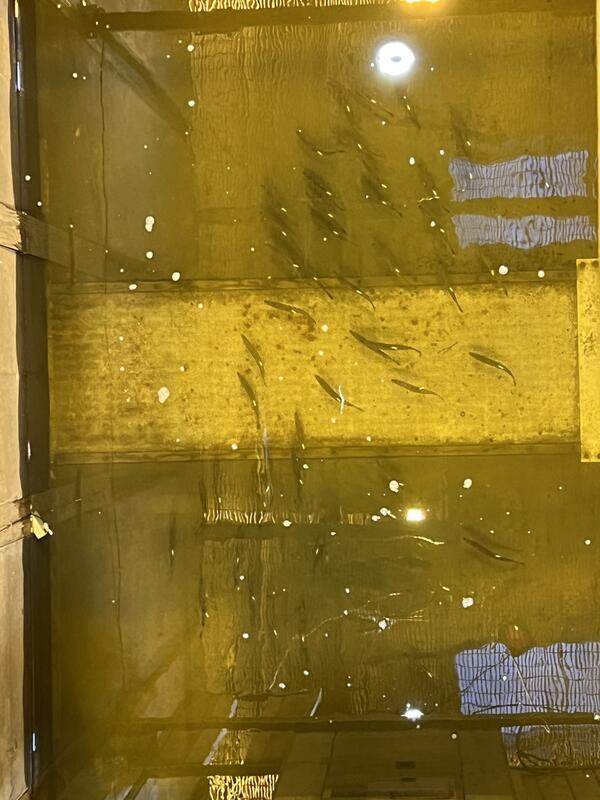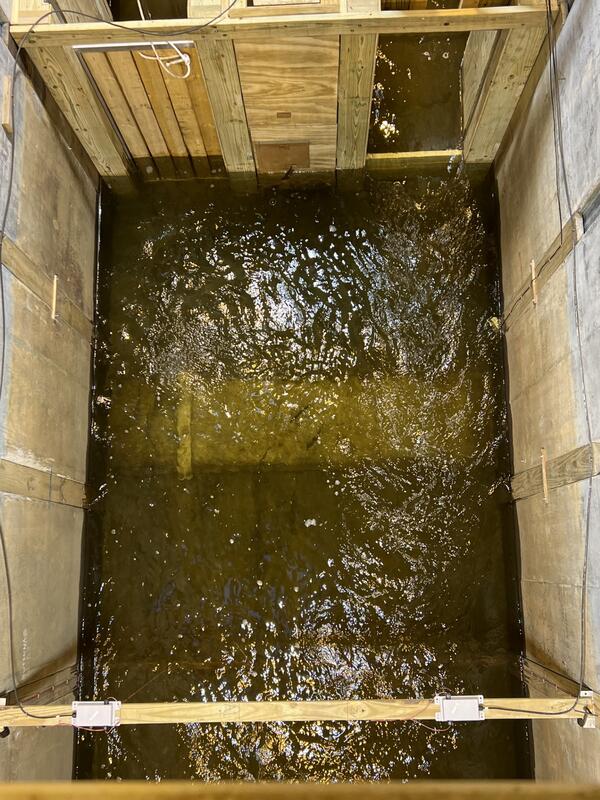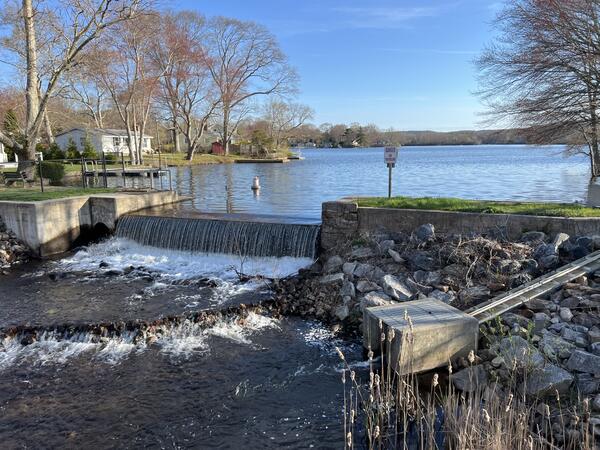This photo shows PIT tagged river herring in the 10 ft wide flume at Conte following the end of a trial as we were draining the flume at the S.O. Conte Research Laboratory Fish Passage Complex.
Kevin B Mulligan
Dr. Kevin Mulligan is Research Hydraulic Engineer at the USGS S.O. Conte Research Laboratory at Turners Falls, Massachusetts
Kevin’s work primarily focuses on improving the performance of fish passage structures through hydraulic modeling and experiments with live, actively-migrating fish. In conjunction to his research, Kevin has served in multiple organizer roles for the International Fish Passage Conference since its inception in 2011 and currently serves as the Vice Chair of the American Fisheries Society Bioengineering Section & American Society of Civil Engineers Environmental Water Resources Institute Joint Committee on Fish Passage. Kevin is also an adjunct professor at the University of Massachusetts Amherst. He received his Doctor of Philosophy Degree in Environmental and Water Resources Engineering specializing in fish passage engineering in 2015. In 2009, he received his Bachelor of Science Degree in Civil Engineering and became an Engineer in Training (E.I.T.).
Professional Experience
Fish Passage Engineer; Region 5 of the United States Fish and Wildlife
Education and Certifications
Doctor of Philosophy Degree in Environmental and Water Resources Engineering, 2015, University of Massachusetts Amherst
Affiliations and Memberships*
American Fisheries Society - Bioengineering Section
American Society of Civil Engineers - Environmental Water Resources Institute
Science and Products
Effect of backwatering a streamgage weir on the passage performance of adult American Shad (Alosa sapidissima)
Wall diffuser velocity effects on American shad (Alosa sapidissima) inside a fishway entrance channel
Fishway Entrance Palisade
Effects of plunge pool configuration on downstream passage survival of juvenile blueback herring
Fishway entrance gate experiments with adult American Shad
Downstream fish passage guide walls: A hydraulic scale model analysis
Hydraulic and biological analysis of the passability of select fish species at the U.S. Geological Survey streamgaging weir at Blackwells Mills, New Jersey
Sensitivity of the downward to sweeping velocity ratio to the bypass flow percentage along a guide wall for downstream fish passage
A computational fluid dynamics modeling study of guide walls for downstream fish passage
Derivation and application of the energy dissipation factor in the design of fishways
Non-USGS Publications**
**Disclaimer: The views expressed in Non-USGS publications are those of the author and do not represent the views of the USGS, Department of the Interior, or the U.S. Government.
Fish Passage Research to Identify the Ideal Fishway Entrance for River Herring (Alosa spp)
Development and Evaluation of the Novel East Coast Fish Ladder
Production, Behavior, and Survival of Juvenile Shad and River Herring
Evaluation and Development of Fish Passage Structures and Technologies
Conservation Engineering
Fish Passage Hydraulic Flume
Prefabricated Zero Ascend Omnispecies (ZAO) Modular Fish Passage Modules Using Advanced Manufacturing Techniques
Flume facility data collection at the S.O. Conte Anadromous Fish Research Laboratory in Turners Falls, MA for the 2016-2017 Fishway Entrance Gate Project

This photo shows PIT tagged river herring in the 10 ft wide flume at Conte following the end of a trial as we were draining the flume at the S.O. Conte Research Laboratory Fish Passage Complex.
This photo shows river herring schooling inside a 6 ft wide holding tank at outside the S.O. Conte Research Laboratory in the days leading up to the trial.
This photo shows river herring schooling inside a 6 ft wide holding tank at outside the S.O. Conte Research Laboratory in the days leading up to the trial.

This photo shows flow over a conventional fish ladder entrance, using a weir at the downstream end of the channel to constrict flow and create the attraction jet. PIT tagged river herring can be seen swimming in the approach area to the entrance.
This photo shows flow over a conventional fish ladder entrance, using a weir at the downstream end of the channel to constrict flow and create the attraction jet. PIT tagged river herring can be seen swimming in the approach area to the entrance.

This photo shows the dam and fish ladder where we collected the river herring in Old Lyme, CT.
This photo shows the dam and fish ladder where we collected the river herring in Old Lyme, CT.
Photo of a 1:4 scale model of the novel d-cylinder fish ladder in the hydraulics laboratory in Turners Falls, MA.
Photo of a 1:4 scale model of the novel d-cylinder fish ladder in the hydraulics laboratory in Turners Falls, MA.
Science and Products
Effect of backwatering a streamgage weir on the passage performance of adult American Shad (Alosa sapidissima)
Wall diffuser velocity effects on American shad (Alosa sapidissima) inside a fishway entrance channel
Fishway Entrance Palisade
Effects of plunge pool configuration on downstream passage survival of juvenile blueback herring
Fishway entrance gate experiments with adult American Shad
Downstream fish passage guide walls: A hydraulic scale model analysis
Hydraulic and biological analysis of the passability of select fish species at the U.S. Geological Survey streamgaging weir at Blackwells Mills, New Jersey
Sensitivity of the downward to sweeping velocity ratio to the bypass flow percentage along a guide wall for downstream fish passage
A computational fluid dynamics modeling study of guide walls for downstream fish passage
Derivation and application of the energy dissipation factor in the design of fishways
Non-USGS Publications**
**Disclaimer: The views expressed in Non-USGS publications are those of the author and do not represent the views of the USGS, Department of the Interior, or the U.S. Government.
Fish Passage Research to Identify the Ideal Fishway Entrance for River Herring (Alosa spp)
Development and Evaluation of the Novel East Coast Fish Ladder
Production, Behavior, and Survival of Juvenile Shad and River Herring
Evaluation and Development of Fish Passage Structures and Technologies
Conservation Engineering
Fish Passage Hydraulic Flume
Prefabricated Zero Ascend Omnispecies (ZAO) Modular Fish Passage Modules Using Advanced Manufacturing Techniques
Flume facility data collection at the S.O. Conte Anadromous Fish Research Laboratory in Turners Falls, MA for the 2016-2017 Fishway Entrance Gate Project

This photo shows PIT tagged river herring in the 10 ft wide flume at Conte following the end of a trial as we were draining the flume at the S.O. Conte Research Laboratory Fish Passage Complex.
This photo shows PIT tagged river herring in the 10 ft wide flume at Conte following the end of a trial as we were draining the flume at the S.O. Conte Research Laboratory Fish Passage Complex.
This photo shows river herring schooling inside a 6 ft wide holding tank at outside the S.O. Conte Research Laboratory in the days leading up to the trial.
This photo shows river herring schooling inside a 6 ft wide holding tank at outside the S.O. Conte Research Laboratory in the days leading up to the trial.

This photo shows flow over a conventional fish ladder entrance, using a weir at the downstream end of the channel to constrict flow and create the attraction jet. PIT tagged river herring can be seen swimming in the approach area to the entrance.
This photo shows flow over a conventional fish ladder entrance, using a weir at the downstream end of the channel to constrict flow and create the attraction jet. PIT tagged river herring can be seen swimming in the approach area to the entrance.

This photo shows the dam and fish ladder where we collected the river herring in Old Lyme, CT.
This photo shows the dam and fish ladder where we collected the river herring in Old Lyme, CT.
Photo of a 1:4 scale model of the novel d-cylinder fish ladder in the hydraulics laboratory in Turners Falls, MA.
Photo of a 1:4 scale model of the novel d-cylinder fish ladder in the hydraulics laboratory in Turners Falls, MA.
*Disclaimer: Listing outside positions with professional scientific organizations on this Staff Profile are for informational purposes only and do not constitute an endorsement of those professional scientific organizations or their activities by the USGS, Department of the Interior, or U.S. Government









